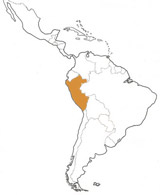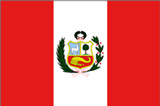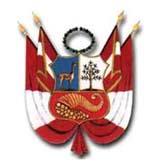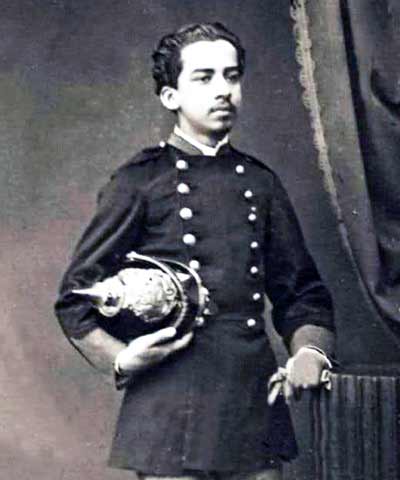Le Pérou a une histoire militaire riche et ancienne. L’influence dominante est demeurée française au cours de l’essentiel du XIXème siècle et d’une grande partie de XX-ème siècle.
Pourtant, contrairement à une croyance répandue, le Pérou, comme la plupart des autres États latino-américains, a, pendant un certain temps, été réceptif à l’influence militaire allemande, après la guerre franco-prussienne de 1870. En fait, de 1872 à 1880, le régiment de cavalerie des Lanceros de Torata N°2 ainsi que le bataillon d’infanterie de ligne Pichincha N° 1, ainsi qu’au moins un bataillon d’un régiment d’artillerie, utilisèrent des Pickelhaube1.
Mais l’engouement germanophile fut de courte durée et, quelques années après, la mode revint à la tradition française. Vers les années 1890, la Garde Présidentielle péruvienne était déjà composée de dragons qui portaient un casque de cuivre de type français. Ainsi, le Pérou, qui aura été le premier État du sous-continent à adopter le style allemand, sera aussi le premier à l’abandonner!
Pourtant, contrairement à une croyance répandue, le Pérou, comme la plupart des autres États latino-américains, a, pendant un certain temps, été réceptif à l’influence militaire allemande, après la guerre franco-prussienne de 1870. En fait, de 1872 à 1880, le régiment de cavalerie des Lanceros de Torata N°2 ainsi que le bataillon d’infanterie de ligne Pichincha N° 1, ainsi qu’au moins un bataillon d’un régiment d’artillerie, utilisèrent des Pickelhaube1.
Mais l’engouement germanophile fut de courte durée et, quelques années après, la mode revint à la tradition française. Vers les années 1890, la Garde Présidentielle péruvienne était déjà composée de dragons qui portaient un casque de cuivre de type français. Ainsi, le Pérou, qui aura été le premier État du sous-continent à adopter le style allemand, sera aussi le premier à l’abandonner!
PERU
Peru declared itself an independent state on July 21, 1821. However, it was not until the victory of the forces led by Simon Bolivar and Jose de San Marin in 1824 against the royalists of Spain that this independence became effective.
During the several wars which raged during the first twenty years of independence, no helmets seem to have been worn by the Peruvian military. Apart from naval operations, the Peruvian military did not face any enemy threats until 1880.
Although the foreign influence on the Peruvian army was clearly French, cavalry regiments of the Lanceros de Torata N°2, the infantry battalion, Pichincha N°1, as well as at least one artillery regiment wore the German Pickelhaube during the years 1872-1880.
Ten years later, the German fashion had disappeared, and the Presidential Guard (PG) had adopted the French-type dragoon helmet.
At the beginning of the twentieth century, new French-style, felt helmets, with front copper emblems, were issued to the PG. Many types of pith helmets were worn by the officers.
In the 1930s the first steel helmet was introduced – the French M26 (called locally the M34) and was accompanied by a locally made, French type liner. These helmets bear a front circular emblem representing Inti, the Inca god. Versions of the M26 were painted in different shades of blue for the Air Force and Navy.
Following the 1941 war with Ecuador, some captured Italian M33 helmets were in use, and in 1946 some US M1917-A1 models were imported. They were never very popular nor widely used.
Beginning in 1950 the US M1, in its different versions, was imported and quickly spread throughout the various military organizations. In the 1970s, an Israeli beige-khaki version of the M1 was introduced and became the standard helmet of the army.
Various other helmets were, or continue to be, used in Peru, including German M1 clones, the Orlite RBH-103, the British LBA and RBR-F5, and the Croatian Sestan Busch BK-3. ABS non-ballistic helmets as well as various PASGTs have also been issued.
The Air Force and Navy have always used the same helmets as the Army but in their respective colors, sometimes with front emblems.
Tank crews have also used many different helmets. Currently the Combat Vehicle Crewman T56-6 seems to be the dominant model.
The Palace Guard as well as the Mariscal Nieto Presidential Guard units are still using a French type cuirassier helmet from the 1940s. The Guardia Civil has traditionally used the same helmets as the Army but with its own emblems.
Peru declared itself an independent state on July 21, 1821. However, it was not until the victory of the forces led by Simon Bolivar and Jose de San Marin in 1824 against the royalists of Spain that this independence became effective.
During the several wars which raged during the first twenty years of independence, no helmets seem to have been worn by the Peruvian military. Apart from naval operations, the Peruvian military did not face any enemy threats until 1880.
Although the foreign influence on the Peruvian army was clearly French, cavalry regiments of the Lanceros de Torata N°2, the infantry battalion, Pichincha N°1, as well as at least one artillery regiment wore the German Pickelhaube during the years 1872-1880.
Ten years later, the German fashion had disappeared, and the Presidential Guard (PG) had adopted the French-type dragoon helmet.
At the beginning of the twentieth century, new French-style, felt helmets, with front copper emblems, were issued to the PG. Many types of pith helmets were worn by the officers.
In the 1930s the first steel helmet was introduced – the French M26 (called locally the M34) and was accompanied by a locally made, French type liner. These helmets bear a front circular emblem representing Inti, the Inca god. Versions of the M26 were painted in different shades of blue for the Air Force and Navy.
Following the 1941 war with Ecuador, some captured Italian M33 helmets were in use, and in 1946 some US M1917-A1 models were imported. They were never very popular nor widely used.
Beginning in 1950 the US M1, in its different versions, was imported and quickly spread throughout the various military organizations. In the 1970s, an Israeli beige-khaki version of the M1 was introduced and became the standard helmet of the army.
Various other helmets were, or continue to be, used in Peru, including German M1 clones, the Orlite RBH-103, the British LBA and RBR-F5, and the Croatian Sestan Busch BK-3. ABS non-ballistic helmets as well as various PASGTs have also been issued.
The Air Force and Navy have always used the same helmets as the Army but in their respective colors, sometimes with front emblems.
Tank crews have also used many different helmets. Currently the Combat Vehicle Crewman T56-6 seems to be the dominant model.
The Palace Guard as well as the Mariscal Nieto Presidential Guard units are still using a French type cuirassier helmet from the 1940s. The Guardia Civil has traditionally used the same helmets as the Army but with its own emblems.




